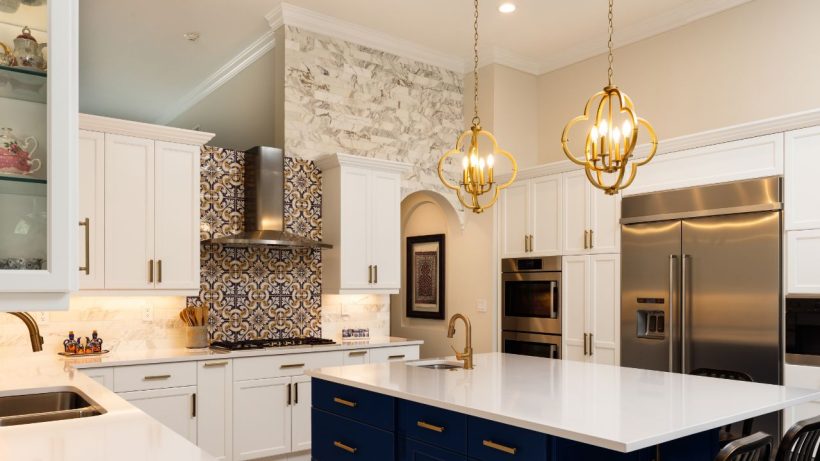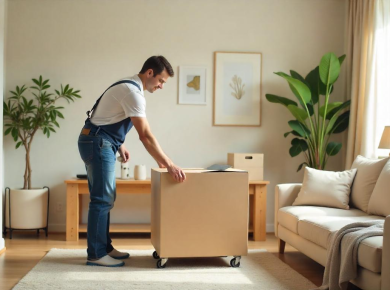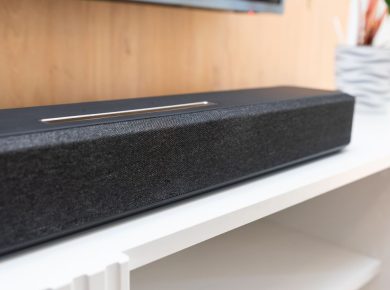The kitchen is the space with the highest potential for chaos. You’re not alone in this with your family. There are spills and crumbs. Most importantly, you’re constantly putting away a multitude of food items and dishes. With a few small rules and organising aids, you’ll be able to organise your kitchen perfectly and say goodbye to disorder forever.
To create order in the kitchen, one should dispose of any unnecessary items. Then, as a general rule, the kitchen is divided into categories: eating tools, cooking utensils, and food items. Finally, one uses organising aids such as canning jars and baskets.
Find out in this article exactly how you can create short-term and lasting order in your kitchen. I have 24 very useful tips for you, so you can turn your kitchen step by step into a perfectly organised family hub.
Why is order in the kitchen important? The kitchen is a prime opportunity for the marketing industry to sell products. Kitchen items are advertised daily in brochures, on television, and online. And hardly anyone can claim to have never fallen victim to ingenious advertising campaigns.
Therefore, consumer experts say that, for example, in the USA in 2004, the average kitchen housed 330 different items and a total of over 1000 items. Even smaller kitchens have more than 650 items on average. These numbers are three times higher than in the middle of the last century.
But it’s not just the total number of items you have to fight with your order. In most kitchens, larger gadgets, in particular, compete for a place in the front row: waffle makers, cooking processors, toasters, recipe books, and so on.
If you want to know exactly where to find what among such a multitude of items, good organisation is extremely important.
Especially if the kitchen has a dining area, it forms the heart of your home. The kitchen is the place where families come close together. Cooking and eating a meal together has been a ritual since the dawn of humanity and serves as an important basis for a functioning family life. That’s precisely why it’s so important to keep the kitchen as simple and clear as possible. You can focus much better on what’s essential: the family.
To feel as comfortable as possible, order in the kitchen helps immensely. On the one hand, the sight of a well-organised kitchen is a good remedy for stress. On the other hand, it helps if you know exactly where to find dishes and food.
Order in the kitchen therefore simplifies your everyday life and, above all, makes preparing meals (cooking, packing lunch boxes, etc.) a pleasure.
- Imagine how you want your kitchen to be organised Everyone interprets order differently. Your partner probably has a different idea of order in the kitchen than you do. It’s the case with my wife and me, anyway. Just as you have to make compromises in other aspects of your relationship, mutual concessions might also help with the new organisation of your kitchen.
To have a common denominator in order, you should first consider the purpose of your kitchen. Here are a few examples of what the kitchen could mean for you:
a) The kitchen is a functional space. It’s all about quick and easy meal preparation. Perhaps you’re also concerned with a practical place for food consumption.
b) The kitchen should bring you inner peace. It’s more than just a room for you. You want to create a comfort oasis.
c) The kitchen is a kind of communication hub. You spend a lot of time here to get together with your partner, family, or friends.
Organise your kitchen according to your goals or the common goals of the family. If, for example, functionality is the focus, you don’t need to worry about ambiance and appearance. But if it’s more about family gatherings, then the order should also be child-friendly (knives and fire out of reach😊).
So when setting your goals, don’t just think about what the kitchen has meant to you so far. Imagine what kind of space it should be for you in the future.
- Empty the shelves and get an overview Even if you have a small kitchen, you’ll be surprised how many items you own in this room alone once you’ve emptied the cabinets and drawers. This gives you three important advantages:
You now have an overview of all the products in your kitchen. And I’d be surprised if there weren’t also items that you had completely forgotten about. Looking into the empty cabinets allows you to imagine how you’d like to reorder your kitchen. Also, consider the purpose the kitchen should serve for you and your family. You have the opportunity to wipe the compartments clean.
sensor kitchen bin
- Get rid of unnecessary kitchen items Even while you’re emptying the kitchen, you’ll notice: Especially in the kitchen, there are usually more items than we really need. You may have plausible reasons for having some items in duplicate and therefore partly unused in your kitchen. For example, by moving in with your partner. Perhaps you’ve also just fallen victim to the smart advertising industry with some dusty appliances.
Don’t worry, you’re not alone. Now is the time to part with them. Because if you haven’t used an item for a year, chances are you’ll never need it again. So be honest with yourself and let go of the unnecessary ballast. Remember, a well-organised kitchen doesn’t depend on the number of items, but on how you can use them efficiently.
However, be careful with letting go of seasonal items. Only because you haven’t used the waffle iron or raclette grill for a year doesn’t mean you should get rid of them right away. Think about whether these items still fit your lifestyle. If you’re unsure, consider a probationary period. Put these items in a box and store them in the basement, for example. If you haven’t used them after another year, it’s time to say goodbye.
- Create categories Now that you have an overview and have disposed of the unnecessary, it’s time to categorise the remaining items. Categorising makes it much easier for you to find a suitable place for everything.
You can divide your kitchen items into the following categories, for example:
Eating utensils: plates, cups, cutlery, etc. Cooking utensils: pots, pans, baking tins, etc. Electrical appliances: toaster, coffee machine, blender, etc. Food: spices, canned goods, pasta, etc. Cleaning supplies: detergent, sponges, dishcloths, etc. Other: cookbooks, decorative items, etc. Naturally, these categories are not set in stone. You can adjust them according to your needs.
- Define a fixed place for each category In the next step, assign a fixed place in your kitchen to each category. This makes it much easier for you to find things and put them back where they belong. Here, too, you should consider the purpose your kitchen serves. If it’s mainly about functionality, the distances between the individual areas should be as short as possible.
If, for example, you have many electrical appliances, it’s practical to have a power strip in this area. This way, you don’t always have to change the plug when using different devices.
To find the ideal place for each category, consider the following:
What do you use most often? These items should be easiest to reach. What do you need where? Pots and pans, for example, belong near the stove. Where do you have the most space? Bulky items should be stored there. Where can you store food? It should be cool and dark here. Where do children have no access? Store dangerous items there.
- Use organising aids Once you have assigned a fixed place to each category, you can use various organising aids to bring order to the individual areas. The following aids have proven to be particularly practical:
Boxes: Ideal for storing smaller items. This way, they don’t fly around loosely in the drawers or cabinets. Shelf inserts: They help to better use the space in high compartments. Door racks: Use the inside of your cabinet doors for storage. Lazy Susans: They ensure that you can easily reach everything in deep cabinets. Drawer dividers: They help to keep order in your drawers. Canning jars: They are not only practical for storing food. They also look good and are stackable.
- Create a place for papers Especially in the kitchen, all kinds of papers accumulate: receipts, recipes, vouchers, and so on. Therefore, create a fixed place where you can store these papers. This can be a folder, a box, or a basket. The main thing is that the papers don’t fly around loosely in the kitchen. This alone creates a lot of order.
- Use the vertical space In many kitchens, the wall space above the work surface is often unused. But especially here, there is valuable storage space. For example, you can attach a rail to the wall and hang various kitchen utensils or spices on it. Shelves or hanging baskets are also suitable for using the vertical space in your kitchen.
- Keep the work surface free The more items on your work surface, the more chaotic your kitchen will seem. Therefore, try to store as many items as possible in cabinets or on shelves. If this is not possible due to lack of space, you can also store items that you don’t use daily in another room. For example, in a storage room or in the basement.
Of course, it’s practical to have items that you use daily within easy reach. However, make sure that there is still enough free work surface available.
- Store food correctly To keep food fresh for as long as possible, you should store it properly. This not only ensures order in your kitchen but also prevents food waste. For example, potatoes last longer in a dark, cool place. Onions, on the other hand, should be stored in a dry place.
To find out how to best store individual foods, you can simply look on the packaging. Often there are hints on it. If not, the Internet also helps.
- Use the FIFO principle for food FIFO stands for “First In, First Out”. This principle comes from logistics and means that the first goods that were stored are also the first to be taken out again. You can also apply this principle to your food supplies.
This way, you prevent food from expiring because it’s been in the cabinet for too long. Especially with food that you buy in stock, it’s advisable to use the FIFO principle.
- Establish fixed places for your shopping Often, new disorder is created when you put your shopping away. Especially if you shop without a plan and buy things that you don’t actually need.
Therefore, create fixed places for the food categories in your cabinets. This way, you immediately know where to put the new purchases. And you avoid buying food that you actually already have.
- Use a shopping list A shopping list helps you to buy only what you really need. This not only saves money but also helps to keep order in your kitchen. Because the less unnecessary food you have in your cabinets, the easier it is to keep them tidy.
Therefore, make it a habit to write a shopping list before every purchase. And more importantly, stick to this list while shopping.
- Regularly check the expiration dates Despite all the precautions, it can always happen that food goes bad. Therefore, make it a habit to regularly check the expiration dates of your supplies. This way, you can use up food in time before it goes bad.
Especially with food that you don’t use daily, it’s advisable to write the expiration date in large letters on the packaging. This way, you have it immediately in view when you open the cabinet.
- Clean up immediately after cooking The biggest source of disorder in the kitchen is probably cooking. No matter how carefully you work, crumbs and spills just happen. Therefore, get into the habit of cleaning up immediately after cooking.
This includes not only wiping the work surface but also putting all utensils back in their place. If you clean up immediately after cooking, the chaos won’t seem so overwhelming. And the next time you cook, you’ll start with a clean kitchen.
- Use a dishwasher if possible A dishwasher not only saves time. It also helps to keep order in your kitchen. Because dirty dishes can be stored in it until you have collected enough for a wash cycle. This way, they don’t pile up in the sink or on the work surface.
If you don’t have a dishwasher, it’s advisable to wash the dishes immediately after use. This prevents a pile of dirty dishes from forming, which not only looks untidy but is also unappetising.
- Regularly clean the refrigerator Just like the cabinets, the refrigerator should be kept in order. This includes not only using the FIFO principle but also regularly cleaning the refrigerator. Because only in a clean refrigerator does the food stay fresh.
Therefore, make it a habit to clean the refrigerator regularly. This includes wiping out the compartments and checking the food for spoilage.
- Keep the sink empty An overfull sink not only looks untidy. It also attracts bacteria and bad smells. Therefore, make it a habit to keep the sink empty. This means not only doing the dishes regularly but also cleaning the sink itself.
For this purpose, you can, for example, use a mixture of baking soda and vinegar. This not only cleans but also deodorises the sink.
- Use a trash can with a lid A trash can without a lid not only looks untidy. It also spreads bad smells and attracts pests. Therefore, use a trash can with a lid. This not only ensures order but also hygiene in your kitchen.
- Be consistent Last but not least, the most important tip for a tidy kitchen is consistency. Only those who consistently follow these rules will have a kitchen that is not only tidy but also stays tidy.
So make it a habit to immediately put everything back in its place after use. And to regularly tidy up and clean your kitchen. This way, you always have a kitchen in which it is not only fun to cook. But also a kitchen that invites you to stay.
By following these practical tips, you can maintain an organized, efficient, and pleasant kitchen space that enhances your cooking experience and overall enjoyment of the space. Happy organizing!









